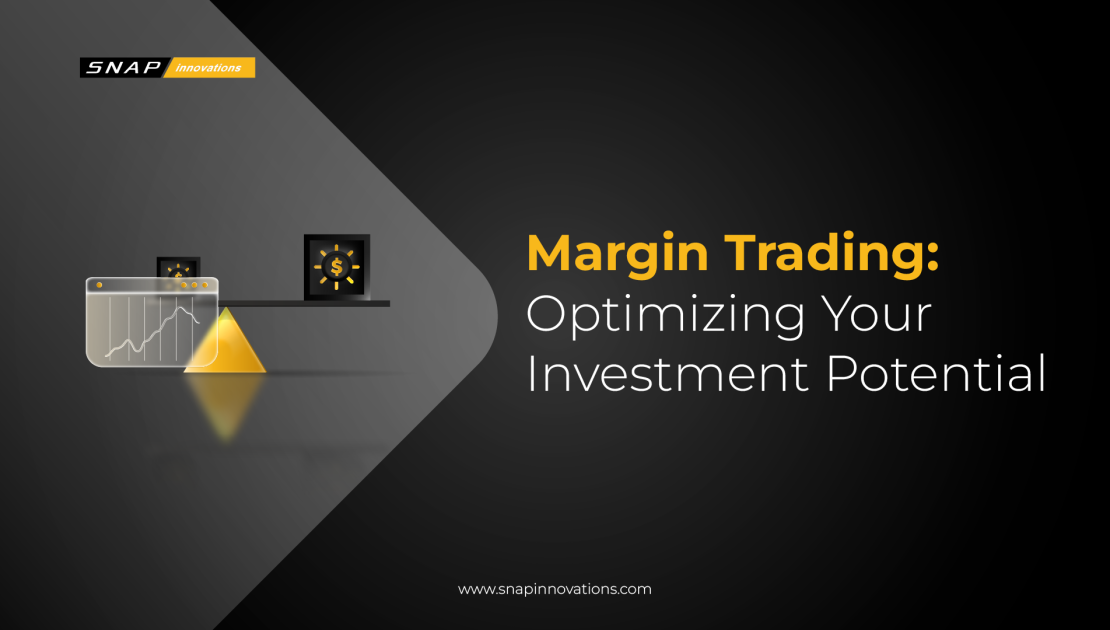In the dynamic realm of financial markets, traders are constantly seeking ways to amplify their investment potential. One such strategy that has gained popularity over the years is margin trading. Margin trading empowers traders to leverage borrowed funds to enhance their trading positions, potentially magnifying profits or losses.
While this approach can be a powerful tool, it also carries inherent risks that demand a deep understanding of the mechanics involved. In this comprehensive guide, we’ll delve into the world of margin trading, exploring what it is, how it works, and the strategies and precautions that traders should consider when engaging in this high-stakes arena.
What is Margin Trading?
Margin trading, a powerful financial strategy, empowers traders by allowing them to borrow funds and amplify their buying power in the financial markets. It works by enabling investors to control positions that exceed their available capital, thus potentially magnifying both profits and losses. This trading approach involves establishing a margin account with a brokerage or exchange, where traders deposit an initial margin and can then borrow additional funds, typically at a cost in the form of interest payments, to execute larger trades.
While margin trading offers the allure of greater returns, it introduces significant risks, as traders may be required to repay borrowed funds even if their trades incur substantial losses. Therefore, understanding the intricacies of margin trading, its mechanisms, and the associated risks is crucial for anyone seeking to explore this strategy. Margin trading provides a mechanism for traders to access a more extensive range of financial assets and markets, including stocks, commodities, cryptocurrencies, and more.
Additionally, margin trading can serve as a hedging tool, helping traders mitigate risks in their portfolios. However, the increased leverage it provides also amplifies potential losses, making it essential for traders to set and adhere to risk management strategies, such as stop-loss orders and position sizing, to protect their capital
How Does Margin Trading Work?
 Margin trading operates on the principle of borrowing funds to trade larger positions. To engage in margin trading, traders open a margin account with a brokerage or exchange, deposit an initial margin, and then borrow additional funds from the platform.
Margin trading operates on the principle of borrowing funds to trade larger positions. To engage in margin trading, traders open a margin account with a brokerage or exchange, deposit an initial margin, and then borrow additional funds from the platform.
1. Margin Account Setup
Setting up a margin account involves a meticulous process. Traders must submit their personal information, financial background, and trading experience to their chosen brokerage or exchange. Depending on the broker’s requirements, there may be different account types available, each with specific eligibility criteria.
Some brokers even require traders to pass assessments or tests to ensure they understand the risks associated with margin trading. Once the account is approved, traders can access the world of margin trading.
Also Read: Quantitative Factor Investing: A Comprehensive Guide
2. Initial Margin
The concept of initial margin is pivotal in margin trading. It represents the minimum amount of capital that traders must deposit to initiate a margin position. The calculation of initial margin is complex and varies between brokers and assets. It depends on factors like the asset’s volatility, market conditions, and the broker’s internal policies.
Traders often use margin calculators provided by brokers to determine the precise initial margin required for their desired trades. High-volatility assets typically demand higher initial margin requirements.
3. Leverage
Leverage is the cornerstone of margin trading. It empowers traders to control larger positions than their available capital. This ratio can vary significantly, such as 2:1, 10:1, or even higher. The ratio signifies how much traders can borrow relative to their initial margin. For instance, with 10:1 leverage, a trader with $1,000 can control a position worth $10,000.
The allure of leverage lies in its potential to magnify profits. However, it’s crucial to acknowledge that it also amplifies potential losses, necessitating stringent risk management strategies.
4. Borrowing Funds
Margin trading essentially involves borrowing funds to bolster the size of trading positions. These borrowed funds are typically provided by the broker, who acts as the intermediary. The broker lends the funds and charges interest on the borrowed amount.
Traders deploy these borrowed funds to acquire additional assets, thereby increasing the potential for gains. However, it’s vital to comprehend that this expansion of positions also escalates exposure to market risks.
5. Interest Charges
Interest charges on borrowed funds are an integral aspect of margin trading. These charges, often referred to as “margin interest” or “financing fees,” can significantly impact a trader’s profitability. Interest rates can fluctuate and are influenced by various factors, including the broker’s policies, the amount borrowed, and prevailing market conditions.
To optimize cost-efficiency in margin trading, traders should diligently scrutinize the broker’s fee structure, compare interest rates, and factor these costs into their overall trading strategy.
6. Margin Calls
Margin calls are crucial components of risk management in margin trading. Brokers enforce maintenance margin requirements to ensure that traders maintain a minimum level of capital in their accounts to cover potential losses. If a trader’s margin account value falls below this maintenance margin due to losses in their positions, the broker may issue a margin call.
This call obliges the trader to deposit additional funds into their account promptly to restore it to the required margin level. Margin calls are essential safeguards designed to prevent catastrophic losses for both traders and brokers.
7. Short Selling
Margin trading provides traders with the unique ability to engage in short selling. This tactic involves selling an asset that the trader does not possess, with the expectation of repurchasing it at a lower price to profit from price declines. Short selling can be an advantageous strategy, particularly in bearish markets.
However, it introduces inherent risks. Unlike buying, where potential losses are limited to the initial investment, losses in short selling can theoretically be unlimited if the asset’s price rises substantially. Traders must approach short selling with caution and implement effective risk management.
8. Risk Management
Effective risk management is the cornerstone of success in margin trading. Traders should employ various strategies to mitigate risk. Setting stop-loss orders is a common practice to limit potential losses. These orders automatically execute a sell order when an asset’s price reaches a predetermined level, helping traders avoid catastrophic losses.
Over-leveraging positions should be rigorously avoided, as excessive leverage can swiftly lead to substantial losses. Diversification is another vital strategy, spreading risk across multiple assets or asset classes. Staying continuously informed about market news, events, and developments is crucial for traders to make informed decisions and swiftly adapt to evolving market conditions.
These comprehensive insights into the intricacies of margin trading provide traders with a profound understanding of its dynamics, risks, and potential rewards. Armed with this knowledge, traders can approach margin trading with a well-informed and disciplined approach, maximizing their chances of success while prudently managing risks.
Strategies for Successful Margin Trading
 Successful margin trading involves a combination of strategies, knowledge, and discipline to navigate the complexities of leveraged trading effectively. One key strategy is conducting thorough research and analysis before executing a trade. Traders should stay well-informed about the assets they’re trading, the markets they’re entering, and the broader economic factors that can influence price movements. Utilizing technical and fundamental analysis can provide valuable insights into market trends and potential opportunities.
Successful margin trading involves a combination of strategies, knowledge, and discipline to navigate the complexities of leveraged trading effectively. One key strategy is conducting thorough research and analysis before executing a trade. Traders should stay well-informed about the assets they’re trading, the markets they’re entering, and the broader economic factors that can influence price movements. Utilizing technical and fundamental analysis can provide valuable insights into market trends and potential opportunities.
Risk management is another critical component of margin trading success. Traders should establish clear risk parameters, including stop-loss orders to limit potential losses. Setting these parameters ensures that traders exit a trade if it moves against them beyond a certain point, preventing catastrophic losses. Position sizing, or determining the appropriate amount to invest in a trade, is equally important. Proper position sizing ensures that traders don’t overextend themselves and can withstand market fluctuations.
Discipline is perhaps the most vital aspect of margin trading. Impulsive decisions, emotional trading, and the temptation to over-leverage can lead to significant losses. Traders should adhere strictly to their trading plan, maintain a cool and rational mindset, and avoid chasing quick profits. Patience is often a virtue in margin trading, as waiting for the right opportunities can yield better results.
Risks and Considerations in Margin Trading
 While margin trading can be a powerful tool, it comes with substantial risks that traders must carefully evaluate. One of the primary risks is the potential for rapid and substantial losses. Let’s explore the risks and considerations of margin trading in even greater depth.
While margin trading can be a powerful tool, it comes with substantial risks that traders must carefully evaluate. One of the primary risks is the potential for rapid and substantial losses. Let’s explore the risks and considerations of margin trading in even greater depth.
1. Market Volatility
Market volatility is an inherent risk in margin trading. Prices of assets can swing rapidly, causing substantial gains or losses. Traders must grasp the nuances of the markets they engage in, employ various technical and fundamental analysis tools, and keep a constant eye on global events and market sentiment.
Understanding historical price patterns and employing risk management strategies, such as setting stop-loss orders, can help traders navigate the unpredictable nature of volatility.
2. Leverage Risk
Leverage amplifies both profits and losses. Different assets and markets have varying leverage limits and requirements. Traders should thoroughly comprehend the specific leverage offered by their broker and use it judiciously.
Managing leverage involves understanding the concept of margin maintenance, which is the minimum equity required to keep positions open. Falling below this threshold can result in margin calls or forced liquidation. Traders must calculate their risk tolerance and employ leverage cautiously.
3. Interest Costs
Margin trading incurs financing costs, including interest rates on borrowed funds. These costs can fluctuate based on market conditions and borrowing rates. Traders should be vigilant about interest rates, as they can significantly impact the overall profitability of trades. Monitoring the cost of borrowing and assessing its impact on the potential return on investment is crucial when deciding to engage in margin trading.
4. Margin Calls
Margin calls are a trader’s worst nightmare. When the value of a margin account falls below a certain level, the broker issues a margin call, requiring the trader to deposit additional funds to meet margin requirements.
Failing to do so can result in the forced liquidation of positions, often at unfavorable prices. To avoid margin calls, traders must understand the maintenance margin requirements for their assets, set appropriate stop-loss orders, and maintain an adequate account balance to cover potential losses.
5. Short Squeezes
Short selling exposes traders to the risk of short squeezes, particularly in highly volatile markets or with assets that are heavily shorted. A short squeeze occurs when the price of a heavily shorted asset rises sharply, forcing short sellers to buy to cover their positions, further driving up the price.
To protect against this risk, traders should closely monitor market sentiment, news, and events that could trigger short squeezes. Using stop-loss orders is a prudent measure to limit potential losses in short positions.
6. Overtrading
Overtrading is a common pitfall for margin traders, driven by the desire to maximize gains. It can lead to exhaustion, impulsive decisions, and significant losses. To avoid overtrading, traders should develop a well-defined trading plan that includes clear entry and exit points, risk-reward ratios, and position sizing guidelines.
Adhering strictly to their plan and avoiding impulsive or excessive trading is crucial for long-term success. Additionally, traders can implement trading automation tools and algorithms to execute their strategies systematically.
7. Psychological Stress
Psychological stress is often underestimated as a risk in margin trading. The emotional rollercoaster of managing leveraged positions can take a toll on a trader’s mental health.
To mitigate this risk, traders should practice emotional discipline, establish a structured trading routine, and consider techniques like meditation or mindfulness to maintain a balanced mindset during volatile market conditions.
8. Regulatory Changes
Regulatory changes can have a profound impact on margin trading. Brokers must adhere to evolving regulatory requirements, which can affect margin limits, trading hours, and more.
Traders should stay informed about regulatory developments in their region and adapt their strategies accordingly to remain compliant. Compliance with Know Your Customer (KYC) and Anti-Money Laundering (AML) requirements is also essential.
These comprehensive considerations underscore the significance of thorough education, disciplined risk management, and a cautious approach to margin trading. Successful traders prioritize knowledge, risk mitigation, and emotional resilience to navigate the challenges of this high-risk, high-reward trading strategy effectively.
Advantages of Margin Trading
Margin trading offers several advantages for experienced traders, making it an appealing option in the financial markets. One of the primary benefits is the potential for amplified profits. By using borrowed funds, traders can magnify their market exposure, potentially increasing their gains when market conditions align with their strategies. This leverage allows traders to maximize their returns, especially during favorable market movements.
Furthermore, margin trading provides an avenue for portfolio diversification. With enhanced leverage, traders can explore a wider range of assets and markets simultaneously, reducing the risk associated with having all investments concentrated in a single asset class. Diversification can be a valuable risk management strategy, helping traders spread risk and potentially offset losses in one area with gains in another.
Another advantage of margin trading is the flexibility it offers in managing one’s portfolio. Unlike traditional investing, margin trading allows traders to profit from both rising and falling markets. Traders can take long positions when they anticipate a market uptrend or short positions when they expect a downtrend. This flexibility can be particularly useful for hedging positions or protecting a portfolio from potential market declines.
Also Read: What Are Liquid Assets? The Financial Lifeline
Conclusion
Margin trading is a sophisticated trading strategy that can significantly enhance a trader’s profit potential but also entails considerable risks. It offers the opportunity to amplify returns through leverage, diversify portfolios, and capitalize on market movements. However, it requires meticulous planning, diligent risk management, and a deep understanding of the associated risks.
Traders considering margin trading should undertake comprehensive research, develop a robust trading plan, and exercise caution at all times. While it can be a valuable tool in the hands of experienced traders, it is not suitable for everyone, and novice traders should gain experience through traditional trading before venturing into margin trading


